Ahoy, squirts! Quint here. A couple weeks back I had the pleasure of going over to Pixar and getting to know a little bit about their next flick, Coco, directed by Lee Unkrich (Toy Story 3) and Adrian Molina.
I got to watch the first act, see presentations from all the heads of departments and even paint my own alebrijes. One of the coolest parts of my journey to Pixar, though, was getting to nerd out a little bit over The Shining with Lee Unkrich, who is even more obsessed with that movie than I am with Jaws, if you can believe it.
If you'll forgive this little detour, I gotta talk about some of this stuff. Before I sat down with Lee, his co-director Adrian Molina and producer Darla K. Anderson I was able to corner Unkrich at a meet and greet thing where I thanked him for his work on TheOverlookHotel.com. Back during my run of Behind the Scenes Pic of the Day I'd pull quite a bit (with credit, of course) from that site which gathers a ton of rare making of materials and stories about The Shining.
He smiled and asked if I wanted to see something cool on his phone. I said yes, of course, and this is what happened...
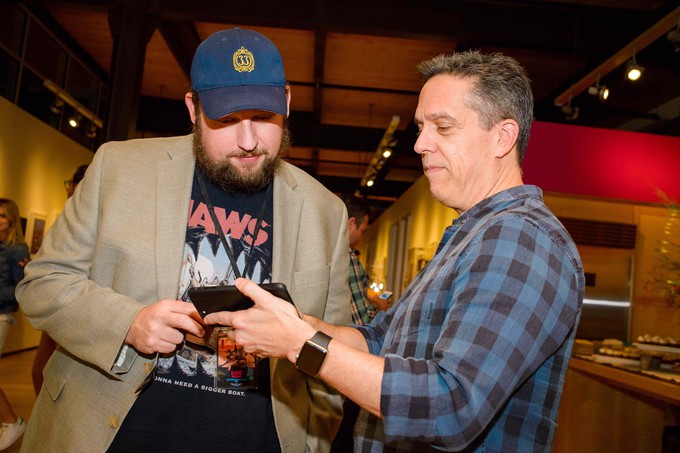
He showed me some amazing 35mm scans of frames from the original ending that Kubrick axed at the last minute. Apparently, deep in Kubrick's archives, were hidden heads and tails of each set up in a book. What Kubrick used to do was make books that had either an early frame or a later frame from a set up and then he'd make notes on that sequence.
Unkrich visited the archives, dug up these frames, and got them scanned and he showed me essentially what the original ending of The Shining was in still form. I saw Wendy sitting in a hospital bed, Ullman coming to visit with flowers in hand and Danny in the hall outside, looking freaked out and staring into the shadows at the end of the hall.
He also showed me some other stills from excised scenes, including one with Danny having one of his episodes while taking a bath. I couldn't tell if that was in the Overlook or if it was pre-journey, but it was a new angle on a movie I thought I knew inside and out already.
And that wasn't it! The next day Unkrich took a break from wall to wall interviews and led me into his office at Pixar so I could meet a friend of his.
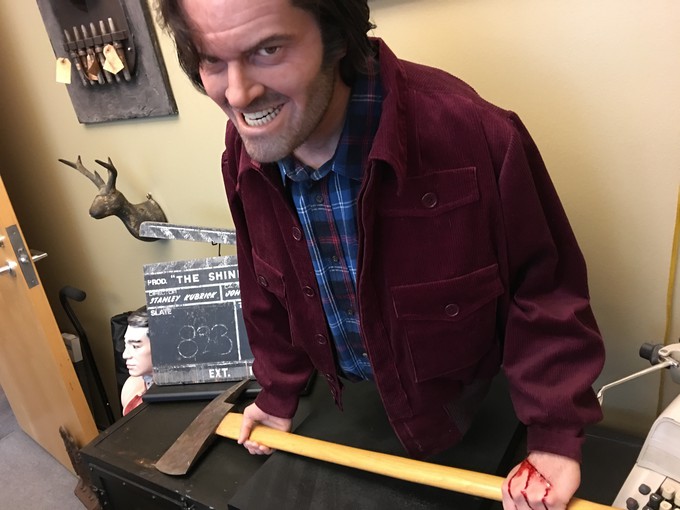
That's cinema history right there. Of course that's a fake Jake Nicholson, but the ax he's holding is one of the hero axes from The Shining. It was heavy, so I wouldn't be surprised if it was the one that actually chopped down that door. The slate next to the statue was also used by Kubrick's crew during the making of the movie.

Neat, right?
I had no idea I'd get such a great dose of classic horror when I came to the family friendly Pixar, but that I did. And then we talked about Coco.
The first act that I saw was actually really great, introducing us to young Miguel and his family. Miguel has a musician's heart, but his family has forbidden all kinds of music after a great-great ancestor abandoned the family to be a guitar player.
Torn between the love of his family and his forbidden passion for music Miguel is at a crossroads and must make a choice between following his heart and shunning his family or leave his passion behind for the sake of those he loves.
This decision comes on the Day of the Dead, when remembering and honoring family is a first priority and his journey takes him between the land of the living and the land of the dead.
Unkrich and I talk a bit about the Holiday itself, his feelings on the comparisons to the Guillermo del Toro-produced Book of Life which covers similar ground and how his young co-director rose through the ranks at Pixar, from story group to director. It's a good chat. Enjoy!

Quint: You've been working on this for a long time, right? You started in 2011 and must have been two or three years into it when Book of Life came out. Was there any frustration on your end when you saw that?
Lee Unkrich: If there was any frustration it was that when I first came up with this idea and we first started down this path we felt like we were doing something completely original, not only in animation, but I had never seen dia de los muertos expressed on film in live action going back through the entire history of cinema. There's some early (Sergei) Eisenstein stuff where he went to Mexico and shot some stuff, but there was almost nothing. This was pre-Spectre.
Quint: And then there's a scene in Batman V Superman, too. It's like you guys were on to something!
Lee Unkrich: Sometimes these things are in the wind. We had two asteroid movies one year. These things happen. So, I knew there would be some similarities between the films since they were both in Mexico and had to do with dia de los muertos, but when we finally saw the film when it came out we were very relieved. I was expecting to have to make big changes in what we were doing because we didn't want to appear that we were copying in any way. Luckily when we saw the film we felt safe that our story was so completely different, other than some elements that would be expected.
Quint: It's clear based on what I've seen so far that there's a different tone and emotion behind your film, too.
Lee Unkrich: They're in the same airspace. We couldn't have avoided it. You can have a lot of different Christmas movies, so why not have a lot of different dia de los muertos movies? The good thing that came out of it is we've gotten to be good friends with Jorge Gutierrez, who directed that, and Guillermo del Toro and they've been super supportive of what we're doing. They've been our biggest fans and have been there to help us in any way they can.
Quint: I'd like to talk a little bit about the creative evolution of you guys crafting this story, in particular how Adrian came on board as co-director. Hearing you, Adrian, talk about this project it's so clear you have a deep passion for this story and culture. Is that what put you on the map in terms of being considered as co-director?
Lee Unkrich: I'll let you talk, but I'm going to talk about you for a second. Thank God for Adrian. Adrian came to Pixar as an intern from CalArts and was hired right out of the internship program. He was on Toy Story 3 with us as a story artist. He was an amazing contributor to that film. A lot of specific humor throughout that film is thanks to Adrian.
Adrian went on to do great work in-between then and now on Monsters University not just designing the title sequence as a storyboard artist, but also contributed some writing on that film as well.
When we started working on Coco I gave our head of story a list of people I wanted working on the film and Adrian was on the top of that list. Luckily when Adrian heard we were doing this movie...
Adrian Molina: They were on my shortlist.
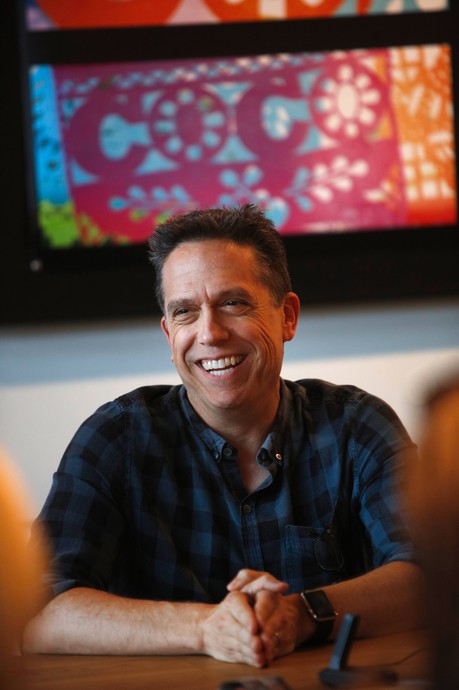
Lee Unkrich: (laughs) Adrian was a story artist on this film for a number of years before his role started to change and it really came out of the fact that we were banging our head against a wall of thorny story issues we couldn't seem to solve. Adrian, as he did on Toy Story 3, was doing a lot of deep thinking about the problems. Even though that wasn't his role, necessarily, he was still, on his own, thinking of them. One day he came to me and said “I've written some pages. You don't have to read them, I just wanted to get this out because I've been thinking about it. If you read them and you find anything useful in them, then please take them.”
I read the pages and I had never seen any of the writing you'd done on Monsters University. I'd heard that you contributed in that way, but I had never actually seen any of your writing. When I read these pages I was completely blown away about how well-written they were. The dialogue was really great, it was funny and because he had the history of being involved in the film for so many years he was able to hit the ground running. He knew what we were up against, he knew where we'd been and the mistakes we had made and was able to forge ahead.
So he began writing and over time was contributing at a higher and higher level until eventually we thought it would be great to have him come on as co-director.
I didn't have a co-director on Toy Story 3 mostly because I've always seen that relationship as being... You don't want two people who are good at the same things. When I was co-director during a number of the early films I had very specific aspects I was responsible for so we could kind of divide and conquer. On Toy Story 3 there was nobody available at that moment that complimented me. I'm not a writer myself. As much as I'd like to be it's not my thing, so it was great to have Adrian come on as a trusted partner and... sorry, I keep talking about you!
Adrian Molina: I love it. I should be recording this!
Quint: I'll send you the audio.
Lee Unkrich: Adrian's a real rising talent in Pixar and we have big hopes and dreams for him as a director for the studio and this was a big opportunity for him to step out from being a story artist and be exposed to how all the sausage is made at the studio.
Adrian Molina: I guess...
Darla K. Anderson: Wait, before he says anything... (laughs) Just kidding.
Quint: And them I'm going to say something.
Darla K. Anderson: Exactly, like a wedding.
Adrian Molina: To add to that, one of the things I've loved about working on this film with Lee and Darla is that they allow me the freedom to find solutions in creative ways. When I started at the studio my language wasn't the written word necessarily, it was drawings and staging. Every time I think about a scene I think about it visually, but they've always been open to breaking the mold and allowing for problems to be solved in new ways. Sometimes that's coming up with an audio sketch, sometimes that is writing lyrics to a song that doesn't exist and maybe shouldn't exist. But they've never created those lines and that gave me the freedom to be creative and contribute solutions in a way that was intuitive to me.
It's been a great way to hone my skills. It's like a training ground to see all the things required in directing a movie and all the things that need to be communicated by a director to make it happen.
Quint: Based on the stuff I've seen you seem to be geared towards directing in that we've seen a few different examples of your problem solving skills, like how you helped build the scene with Miguel in the attic when it felt like Miguel's deep longing to be a musician wasn't coming across as authentic. Problem solving is one of the big jobs of being a director. How are you liking it now that you're actually doing it?
Adrian Molina: It's a completely different job, which is fun because as you're growing as a filmmaker and artist you want to challenge yourself. The last 9 years has been “Give me a challenge and I'm gonna go away to my silent little room, I'm going to craft you something beautiful and I'm going to surprise you with it.” As a co-director I have less time to be personally creative and a lot of it comes from realizing I need to learn how to communicate those ideas so that other people can take that idea, go off into their silent little room and surprise me.
Lee's the type that will leave room for the artist to surprise him because that's where a lot of our best ideas come from.
Quint: Before I have to wrap up, I wanted to touch a little bit on tone. On a project like this you have a fine balance. You're dealing with the undead and established cultural iconography. You don't want to be disrespectful, but you also know you're aiming for a family audience. How do you approach this story that takes us into the land of the dead without making it too scary for younger audiences?
Lee Unkrich: Historically, part of the dia de los muertos has to do with irreverence. There's that aspect to, a mocking of death. It's not all of it, but it's part of it. We wanted to try to capture that.
Adrian Molina: Yeah, it's playful. The benefit of having a character who can actually go and meet all these people who he's heard all these stories about... When you're remembering and telling these stories there's a certain respect you want to give, but when you can just meet these characters and let these characters be the people they were in life then you have a little more leeway to bring them down to real person or a real friend that I'm interacting with.
Quint: There's also something really lovely about his long dead relations knowing him so completely even though they were never alive at the same time.
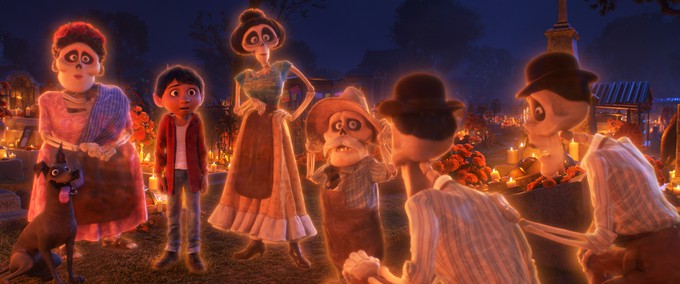
Lee Unkrich: Yeah, because presumably they come back every year and watch him grow up over time. There's a familiarity with them, certainly. But to continue on your tone question, personally my favorite movies are movies that put you through a broad range of emotions. Not many do that. Most films are either a comedy or they're a horror movie or an adventure. Sometimes there's some overlap in that Venn Diagram, but there's not a lot of movies that do it all.
I think at our best Pixar films gives you a full array of experiences, from comedy to being frightening to being really sad, sometimes. This story... I hope people think we've threaded all those needles along the way because I think it does all of those things and I hope people feel that full satisfaction of having a great, well-rounded experience watching the film.
Darla K. Anderson: There's also a sweetness with Miguel and his family. Even through all the disparities they all sweetly adore and love each other. Our movie hangs on that thread, that we know that the family is truly committed and loves each other.
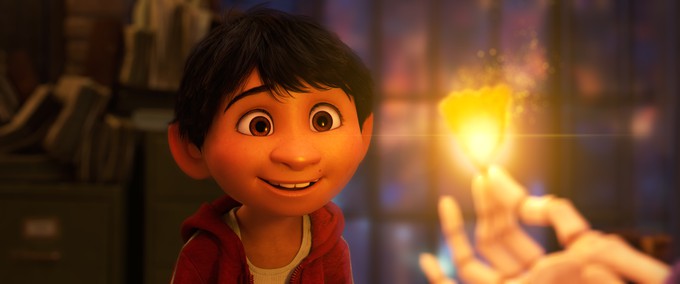
And there you have it. From classic film props to heartwarming family films, all covered in one story! Lotsa ground covered!
Stay tuned for a little more insight into Coco (and a lot more imagery) as I take you through my time at Pixar, some reaction to the first act of the movie and some peeks behind the curtain at the development process. That story should be up tomorrow morning, so keep your eyes peeled!
-Eric Vespe
”Quint”
quint@aintitcool.com
Follow Me On Twitter

